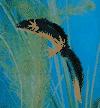- newt
-
/nooht, nyooht/, n.1. any of several brilliantly colored salamanders of the family Salamandridae, esp. those of the genera Triturus and Notophthalmus, of North America, Europe, and northern Asia.2. any of various other small salamanders.[1375-1425; late ME newte, for ewte (the phrase an ewte being taken as a newte; cf. NICKNAME), var. of evet, OE efete EFT1]
* * *
or eftAny of more than 40 salamander species (family Salamandridae) prevalent in the southeastern U.S. and Mexico and also found in Asia and Great Britain.Aquatic species are called newts; terrestrial species are called efts. Newts have a long, slender body, and the tail is higher than it is wide. They eat earthworms, insects, snails, and other small animals. Both aquatic and terrestrial species breed in ponds. The three species (genus Triturus) in Britain are sometimes called tritons. The red eft (Notophthalmus viridescens) of eastern North America is bright red during its terrestrial youth, after which it becomes permanently aquatic and dull green. Warty newt (Triturus cristatus)Toni Angermayer
Warty newt (Triturus cristatus)Toni Angermayer* * *
generic name used to describe several partially terrestrial salamanders (salamander). The family is divided informally into newts and “true salamanders” (that is, all nonnewt species within Salamandridae regardless of genus). Since there is little distinction between the two groups, this article considers the family as a whole.Salamandridae is second in diversity to the lungless salamanders (lungless salamander) (family Plethodontidae); the family is made up of 15 genera of true salamanders and over 50 species of newts. Salamandridae has a spotty geographic distribution throughout the Northern Hemisphere and occurs from western Europe to the Urals, from southern China to Japan, on the west coast of North America, and east of the Rocky Mountains in the eastern United States. Salamandrids range from moderately slender to robust-bodied forms. All have well-developed limbs and tails. They are usually less than 20 cm (8 inches) in total length, and many are less than 10 cm (4 inches). Newts have rough skin, and the skin of many salamanders is rugose (wrinkled).Adults of most species lay eggs (egg) in water, and individuals pass through an aquatic larval stage before metamorphosing (metamorphosis) into adultlike body forms. Three life histories occur among salamandrids with aquatic larvae. In some genera, such as the Asian Cynops and the European Pleurodeles, the larvae metamorphose in the water, and juveniles and adults remain aquatic. In the European newts (Triturus) and western North American newts (Taricha), the larvae metamorphose into terrestrial juveniles that remain terrestrial as adults; adults return to water only for courtship and egg deposition. In the eastern North American newts (Notophthalmus), the larvae metamorphose into a terrestrial juvenile, referred to as the eft stage; efts spend two to four years on land. As they begin to mature sexually, they return to water and become aquatic as adults.Live-bearing salamandrids, such as the alpine salamander (Salamandra atra) and Luschan's salamander (Lyciasalamandra luschani), also exist; they retain their eggs in the oviduct and give birth to miniature adultlike offspring. A few other species lay eggs on land.All members of Salamandridae are toxic and have either poisonous skin or glands (gland) that secrete poison when threatened. In general, the terrestrial species, such as Taricha, and the efts of some aquatic species have the most-toxic skin secretions. Commonly, these poisonous salamanders are brightly coloured to advertise their toxicity to potential predators.George R. Zug* * *
Universalium. 2010.
